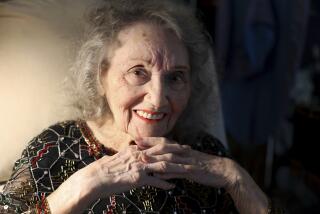Dorothy Young dies at 103; dancer appeared in Houdini’s final tour
Dorothy Young was a 17-year-old New York City tourist in 1925 when she spotted an ad placed by master illusionist Harry Houdini seeking “girl dancer for Broadway show and tour of the United States.”
She scurried to the tryouts and shyly hid in the back before being summoned to audition by Houdini and his manager. After breaking out in a Charleston, she was hired on the spot.
When her mother and father, a minister, refused to allow her to join the traveling stage show, Houdini persuaded her parents that he and his wife “would look after me as their very own daughter, which they did,” Young recalled in a 2000 oral history. “It was a wonderful, wonderful year.”
Young, who was the last surviving member of Houdini’s stage troupe, died March 20 at her home in Tinton Falls, N.J. She was 103.
The cause was complications related to old age, said Dave Muha, a spokesman for New Jersey’s Drew University, where she was a major donor.
In Houdini’s act, Young debuted as the “Radio Girl of 1950,” a fanciful take on radio reception of the future. While she hid inside a huge mock radio, the magician would pretend to tune in a local radio station and ostensibly make her appear out of thin air.
Out would pop Young to perform an energetic Charleston in a costume she later remembered as “very, very scanty.”
The show toured the eastern United States and played Broadway in 1926.
Houdini’s wife, Bess, was also a stage assistant and became a close friend.
“Mrs. H, I always called his wife that, was so much fun! She took care of me,” Young told the Asbury Park Press in 2002.
The media portrayed Houdini as “egotistical and temperamental” but he was “kind and compassionate,” Young recalled in the 2000 oral history of Monmouth County, N.J., where she lived later in life.
Two months after she left the show in 1926, Houdini died on Halloween from complications of appendicitis.
Interviewers repeatedly asked if she knew how Houdini managed such seemingly impossible feats as escaping from a locked, water-filled milk can. She had a ready reply: “Of course, but I am sworn to secrecy.”
Houdini told Young that he had chosen her over 200 others because he and his manager had “opposite personalities, and you appealed to both of us,” she recalled in the oral history.
Young had another theory.
“All of those girls were typical Broadway girls, and they weren’t going to have someone like that travel with them closely,” she said in the oral history. “And the other thing, I was shorter than Houdini,” who was about 5 feet 5, “and most of them were taller.”
She was born May 3, 1907, in Otisville, N.Y., one of four children of a fifth-generation Methodist minister. Her grandfather was an Army chaplain who died after being wounded in the Civil War.
While attending Beaver College in Pennsylvania, she was inspired to become a dancer after seeing Russian ballerina Anna Pavlova perform.
Soon after leaving Houdini’s show, she married Robert Perkins, an FBI agent she met at a Greenwich Village party. The marriage ended in divorce.
Eventually, she appeared in several Broadway shows and met Gilbert Kiamie, the son of a silk-lingerie magnate, who became her dance partner. Performing as Dorothy and Gilbert, they gained attention for a Latin dance they called the “rumbalero.”
She also danced in early films, including “Flying Down to Rio” (1933) with Fred Astaire, according to Drew University.
In 1943, Young married Kiamie and moved to Pelham, N.Y. He died in 1992.
She started studying oil painting in the 1940s, and many of her works hang at Drew, where her brother Sherman was a winning baseball coach and her father pursued a divinity degree.
In 2000, Young gave more than $13 million to the university to help build the Dorothy Young Center for the Arts.
At the center in 2008, she helped commemorate the 82nd anniversary of Houdini’s death. As she had before, Young participated in a seance attended by an inner circle of Houdini enthusiasts and historians. At 101, she was the only person present who had known and worked with him in this life.
She is survived by her son, Robert E. Perkins Jr.; three grandchildren and nine great-grandchildren.
More to Read
Start your day right
Sign up for Essential California for the L.A. Times biggest news, features and recommendations in your inbox six days a week.
You may occasionally receive promotional content from the Los Angeles Times.





